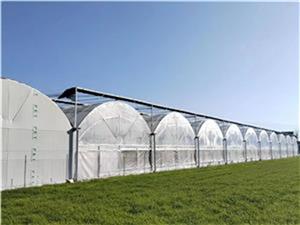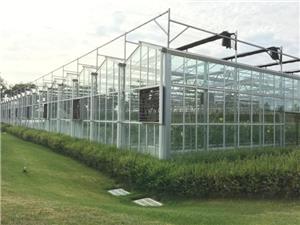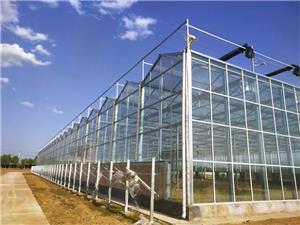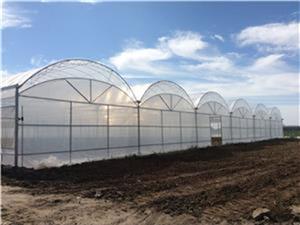In modern agricultural production, greenhouses, with their ability to control the internal environment, have become crucial facilities for ensuring the stable growth of crops and realizing annual production. Different types of greenhouses vary in material selection, structural design, functional characteristics, and cost, making them suitable for different planting needs and Glass Greenhouse application scenarios. The Glass Greenhouse following is a detailed introduction to five common types of greenhouses in agriculture.
I. Glass Greenhouses
Glass greenhouses, with their excellent light transmittance, are ideal for growing crops with high light requirements, as they can maximize the satisfaction of crops' light needs for photosynthesis.
(I) Covering Materials and Specifications
There are mainly two types of covering for glass greenhouses: one is full glass covering, and the other is PC sunlight panels used for the top and glass for the surrounding walls. Glass can also be divided into single-layer and double-layer. For scenarios with high light transmittance requirements, float flat glass or diffused glass is usually selected, with conventional specifications including 4 + 9 + 4, 5 + 6 + 5, 5 + 9 + 5, etc. In areas with frequent hailstorms, thicker glass is recommended to enhance impact resistance. If PC sunlight panels are used for the top, the thickness is mostly 8 - 12mm. Manufacturers usually provide a 10-year warranty for such sunlight panels, and their actual service life can reach 15 - 20 years.
(II) Main Structure and Configuration
The main structure adopts hot-dip galvanized light steel structure, with the surface treated with anti-corrosion coating. This not only reduces Glass Greenhouse the steel consumption per unit area but also ensures a long service life of the truss structure, providing stable support for the greenhouse. The internal configuration of the greenhouse is extremely complete, including the main framework, internal and external sunshade systems, skylight and side window ventilation systems, fan and wet curtain forced cooling systems, Internet of Things (IoT) systems, sprinkler and drip irrigation systems, seedbeds, supplementary lighting systems, etc. These configurations can accurately regulate the light, temperature, humidity, water, and fertilizer in the greenhouse, fully meeting the annual production needs of various crops. In cold regions in northern China, additional heating equipment is required to ensure crop growth in winter Glass Greenhouse.
(III) Common Specifications and Application Scenarios
Common span sizes are 8m, 9.6m, 10.8m, and 12m, bay sizes are 4m and 8m, and eave heights range from 3m to 9m. Customization is also available according to users' specific needs. Due to its superior performance, it has a wide range of applications, including vegetable cultivation, flower cultivation, seedling propagation, ecological tourism, scientific research experiments, vertical planting, special-shaped design, and leisure experience. The corresponding greenhouse types are vegetable glass greenhouses, flower glass greenhouses, seedling glass greenhouses, etc.
(IV) Cost
Among the five types of greenhouses, glass greenhouses have the highest cost, with a cost of 330 - 400 RMB per square meter under standard configuration.
II. PC Sunlight Panel Greenhouses
Polycarbonate (PC) is an engineering plastic with excellent comprehensive performance, featuring outstanding physical, mechanical, electrical, and thermal properties, hence it is known as the "King of Transparent Plastics". The hollow panels made of PC are a new type of high-strength, light-transmitting, and energy-saving material widely used in greenhouse construction, with advantages that other materials cannot match.
(I) Material Characteristics
PC sunlight panels are lightweight, facilitating installation and maintenance; they have good anti-condensation performance, which can prevent adverse effects of condensation in the greenhouse on crops; they have excellent light-collecting effect, meeting the light needs of most crops; they have good load-bearing performance, capable of withstanding a certain amount of wind and snow pressure; at the same time, they have excellent thermal insulation performance, helping to maintain a stable temperature environment in the greenhouse; they also have strong impact resistance, durability, and an elegant appearance, which can improve the overall quality of the greenhouse.
(II) Application Scenarios
With its large-span pointed-roof design, PC sunlight panel greenhouses have spacious internal operating space, high greenhouse utilization rate, and good display effect. They are mostly used in large-scale sightseeing greenhouses, seedling greenhouses, flower markets, greenhouses supporting large shopping malls, and ecological restaurants. They Glass Greenhouse can not only meet production needs but also take into account ornamental and leisure functions.
(III) Cost
Under standard configuration, the cost of PC sunlight panel greenhouses is 200 - 300 RMB per square meter, which is lower than that of glass greenhouses, offering relatively high cost-effectiveness Glass Greenhouse.
III. Double-Layer Inflatable Greenhouses Glass Greenhouseenhouses have unique features in structural design and thermal insulation performance, effectively adapting to the seedling and production needs of different crops.
(I) Core Features
Drainage and Thermal Insulation Design: A large-flow drainage trough design is adopted to fully meet the drainage needs of the greenhouse and prevent damage to the greenhouse structure caused by rainwater accumulation. The double-layer inflatable film is the core advantage of this type of greenhouse. It can effectively prevent heat loss in the greenhouse and isolate the invasion of cold air from the outside, resulting in excellent thermal insulation performance, which significantly reduces the operating cost of the greenhouse in winter. However, the double-layer inflatable film also has a drawback: it leads to a certain decrease in the light transmittance of the greenhouse.
Structural Performance: The top purlins and arch bars all adopt "several"-shaped steel. This design not only significantly improves the anti-condensation performance of the greenhouse itself but also makes the greenhouse structure more solid, enhancing thermal insulation Glass Greenhouse and wind-snow resistance, and providing a stable growth environment for crops under different climatic conditions.
(II) Application Scenarios
It is suitable for forestry seedling raising, fruit tree seedling raising, flower planting, vegetable seedling raising, and production, providing suitable environmental conditions Glass Greenhouse for the growth stages of various crops.
IV. Single-Layer Film Multi-Span Greenhouses
Single-layer film multi-span greenhouses are widely used in agricultural production due to their simple structure and cost-effectiveness.
(I) Main Structure and Covering Materials
The main structure of the greenhouse adopts a hot-dip galvanized steel framework. After hot-dip galvanizing treatment, the anti-corrosion performance of the framework is greatly Glass Greenhouse improved, with a service life of more than 20 years. In terms of covering materials, single-layer film is used for both the top and surrounding walls. The film material has low cost and is easy to replace.
(II) Specification Design
Common span specifications include 6.0m, 8.0m, 10.0m, etc., allowing users to choose according to the planting scale and site conditions. At the same time, special designs can be made according to different climatic conditions in various regions to adapt to local natural environmental factors such as temperature, wind force, and precipitation. Other design requirements can refer to the standard multi-span greenhouses.
V. Single-Arch Greenhouses
Single-arch greenhouses have a simple structure and strong targeting, and have certain advantages in specific crop planting and breeding fields.
(I) Structural Performance
The steel pipes of the single-arch greenhouse framework adopt the hot-dip galvanizing process, which effectively improves the anti-corrosion ability and service life of the framework. Its wind resistance reaches 25m/s, and its snow resistance is 15cm, which can resist severe weather to a certain extent and ensure the safety of the greenhouse.
(II) Application Scenarios
It is suitable for vegetable and melon cultivation, flower seedling raising, fruit tree planting, and other breeding industries, providing basic environmental protection for these crops and breeding projects and meeting their basic growth and breeding needs.
VI. Comparative Summary of the Five Greenhouse Types
The above five types of greenhouses have obvious differences in many aspects, with specific comparisons as follows:
Covering Materials: Glass greenhouses mainly use glass and PC sunlight panels (for the top) as covering materials; PC sunlight panel greenhouses mainly use PC hollow panels; double-layer inflatable greenhouses, single-layer film multi-span greenhouses, and single-arch greenhouses all use film as covering materials, among which double-layer inflatable greenhouses use double-layer film, and the latter two use single-layer film.
Cost: Glass greenhouses have the highest cost (330 - 400 RMB/m²), followed by PC sunlight panel greenhouses (200 - 300 RMB/m²). The latter three types of greenhouses using film as covering materials have the lowest cost, with a cost of 80 - 160 RMB per square meter, making them cost-effective greenhouses.
Application Scenarios: Glass greenhouses and PC sunlight panel greenhouses have a wider range of application scenarios, covering production, sightseeing, scientific research, leisure, and other fields; double-layer inflatable greenhouses, single-layer film multi-span greenhouses, and single-arch greenhouses focus more on crop seedling raising and production, among which single-layer film multi-span greenhouses and single-arch greenhouses are particularly widely used in vegetable, seedling, melon, and flower planting.
Different types of greenhouses have their own advantages and application scopes. Farmers and relevant practitioners can reasonably select the most suitable type of greenhouse according to their own planting needs, capital budget, site conditions, and local climatic environment to achieve efficient and stable development of agricultural production.




